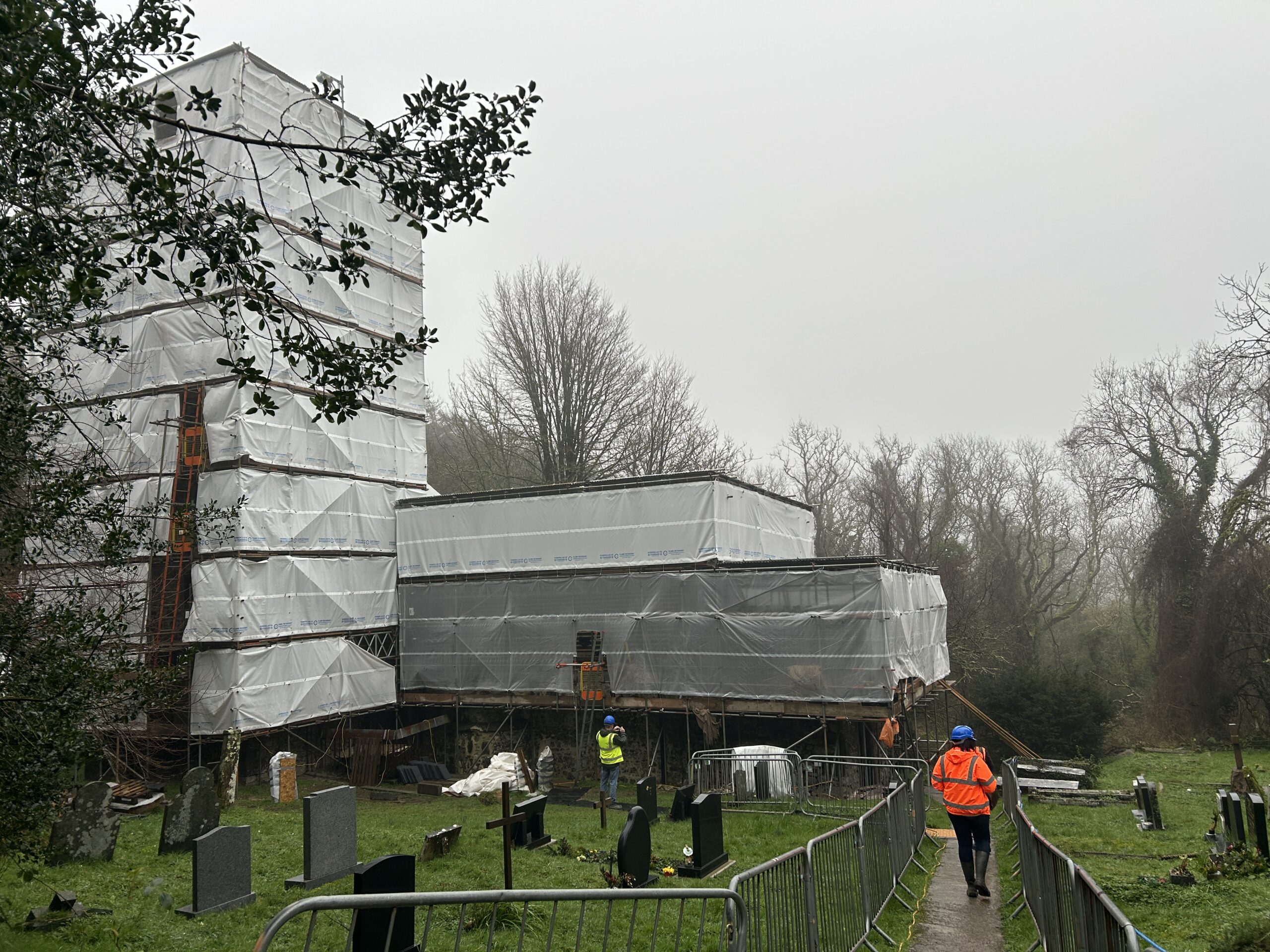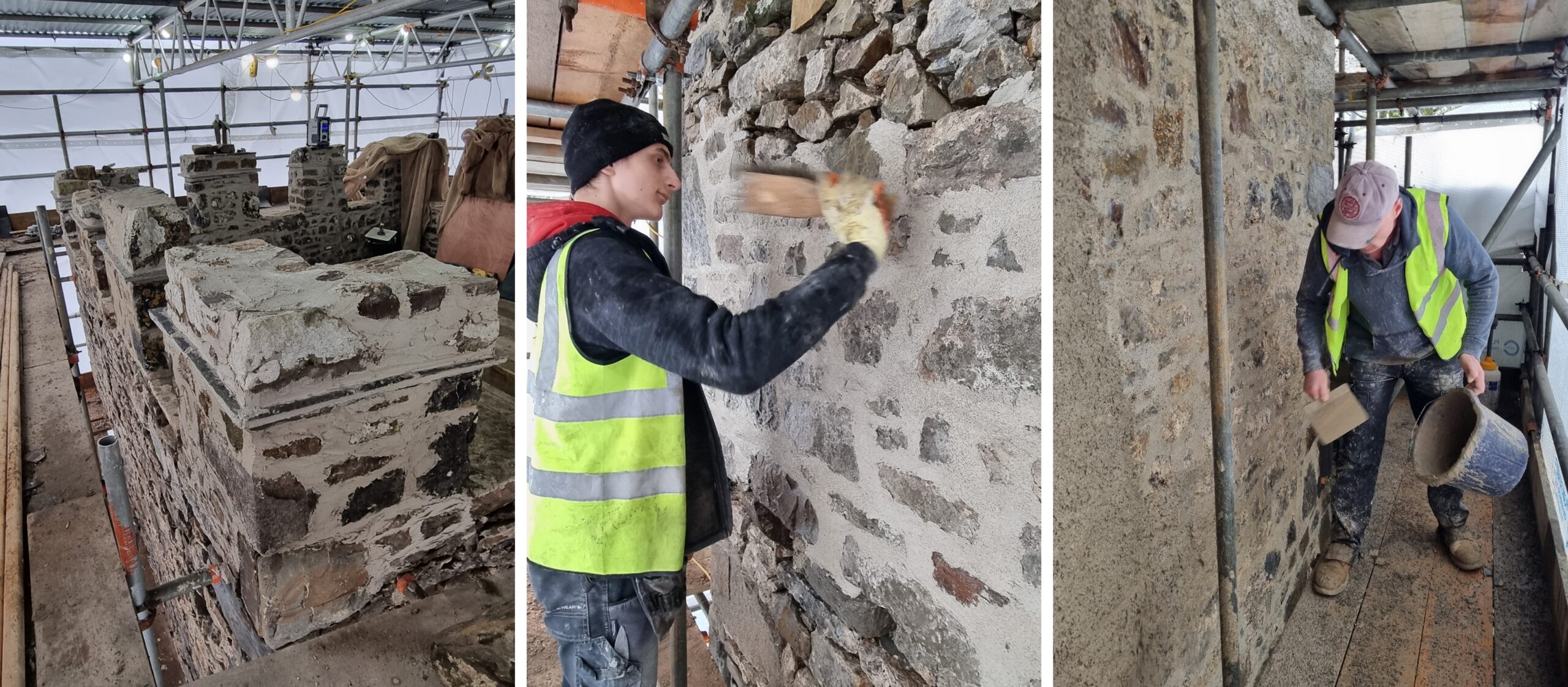
Published: 15/05/2024
Updated: 17/05/2024
Day by day, against the odds, the venerable church of St Lawrence is emerging from the stranglehold of decay.
I can't quite believe the transformation that is taking place at St Lawrence's. Twelve months ago, we still didn't have a grant for the repairs secured, the church was choked by ivy, the pews rotting in pools of rainwater, and we had grave concerns about the dilapidated roofs surviving another winter.
In 2023, a grant from the NHMF, truly a lifeline, turned everything around. It covered 74% of the costs. This was followed by a grant of £212,932 from Cadw's Heritage at Risk scheme which closed the funding gap further. No time was wasted in getting to site. Once ecology licences and local authority permissions were in place, the work was tendered and the contract won by Tree & Sons, a heritage contractor based in Milford Haven. As detailed in my last update, Tree & Sons started work in October 2023, and the first month was spent getting the site ready; that is, organising a welfare cabin and toilets, erecting an access bridge over the churchyard wall, assembling full scaffolding and a temporary roof. Given the persistent wet weather, that temporary roof has proved a life-saver, as it's made it possible to work on the roofs throughout the winter and spring.

Starting from the top: there are three different types of roofs at St Lawrence's. The slate and batten slopes to nave, chancel, transept and vestry; a heavy Red Sandstone roof over the porch, and a metal roof on the tower. The repair of all of these roofs is nearly complete. That means, the structural timbers have been replaced, mended or strengthened as needed, new battens have been laid, slates relaid, new ridge-tiles cut and bedded, and new flashings installed to provide extra protection at junction points. Seeing as poor old St Lawrence's has been leaking in one way or another for about 200 years, we really want to do the best job possible with the roofs this time, and are taking great care with materials and detailing.


After the roofs, our next priority was the walls. Built of limestone rubble, the walls were packed out with rock-hard cement mortar and snail-creep pointing. This was trapping moisture within the rubble core of the walls, and had to go. The contractors carefully cut out this impervious cement, and repacked deep voids with a hot-mixed lime mortar. They then harled the tower with a hot-mixed lime. This involves a flick of the whisk and flinging mortar at speed onto the wall. This is a traditional technique, but the harling action gets the mortar into all the crevices, and creates a rough-cast finish. At of writing, the tower has had three coats of creamy lime-wash. It will get one more before the tower scaffold is dismantled.
We know this change in appearance in the tower will surprise a lot of people, but there is evidence that the tower was historically rendered and white-washed, rather than bare stone, and furthermore, this coating will give the structure another layer of protection against the elements.


Internally, with a wall-paintings conservator keeping a watching brief, the non-breathable yellow emulsion has been carefully removed. Again, this was holding moisture and contributing to the high humidity in the church. Since removing this, it feels as though the church has breathed a sigh of relief. Already the interior is feeling drier and happier. In the coming weeks, we will begin lime-washing the interior - but not the entire interior, as our wall-paintings conservator has identified several areas where there is evidence of medieval wall-paintings.
The wall-paintings are one of the most exciting parts of this project. We just do not know what survives and to what extent. As soon as the main contractors have finished mending the building envelope (roofs and walls), the conservators can move in and begin their intricate work. These paintings need the highest care — the ivy that cloaked the church externally had also worked its way inside. It wormed under the yellow emulsion and in the dark and dank environment, the roots thrived. It's astonishing to see, but the roots are damaging the precious paintings. In some cases, tiny rootlets — just the thickness of a hair — have penetrated one of the paper-thin layers of paint and separated it from the substrate or layer below. To remove this without losing any of the historic paint will be a challenge to say the least. In addition to this, almost everywhere, leached lime from the plaster has formed a calcite bloom on the surface, obscuring the painting beneath. These deposits can attract atmospheric moisture, grow, and cause further deterioration, so we need to deal with these too.

So, that's where we are. We are 70% of the way through the main contract. We've still got to sort out the electric installation and internal lighting, and lay a new drainage system. But before then, we do have an open day on 8 June, where you can come and meet our team at the church. You can read more and book on here.
Finally, I cannot sign off an update without giving my deepest thanks to all the people that make this possible:
And to our funders, donors and everyone who cares about this place. Thank you.


Can you help us with our work? We care for more than 64 redundant places of worship in England and Wales — historic buildings which need continual maintenance — and we save more every single year.
Our sincere thanks to everyone who supports our work.